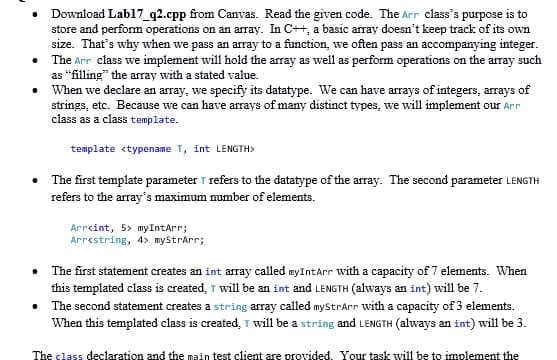Download Lab17_q2.epp from Canvas. Read the given code. The Arr class's purpose is to store and perform operations on an array. In C++, a basic array doesn't keep track of its own size. That's why when we pass an array to a function, we often pass an accompanying integer. • The Arr class we implement will hold the array as well as perform operations on the array such as "filling" the array with a stated value. When we declare an array, we specify its datatype. We can have arrays of integers, arrays of strings, etc. Because we can have arrays of many distinct types, we will implement our Arr class as a class template. template The first template parameter 1 refers to the datatype of the array. The second parameter LENGTH refers to the array's maximum number of elements. Arrcint, 5> myIntArr; Arrestring, 4> mystrArr; • The first statement creates an int array called myIntArr with a capacity of 7 elements. When this templated class is created, T will be an int and LENGTH (always an int) will be 7. • The second statement creates a string array called mystrarr with a capacity of 3 elements. When this templated class is created, T will be a string and LENGTH (always an int) will be 3.
Download Lab17_q2.epp from Canvas. Read the given code. The Arr class's purpose is to store and perform operations on an array. In C++, a basic array doesn't keep track of its own size. That's why when we pass an array to a function, we often pass an accompanying integer. • The Arr class we implement will hold the array as well as perform operations on the array such as "filling" the array with a stated value. When we declare an array, we specify its datatype. We can have arrays of integers, arrays of strings, etc. Because we can have arrays of many distinct types, we will implement our Arr class as a class template. template The first template parameter 1 refers to the datatype of the array. The second parameter LENGTH refers to the array's maximum number of elements. Arrcint, 5> myIntArr; Arrestring, 4> mystrArr; • The first statement creates an int array called myIntArr with a capacity of 7 elements. When this templated class is created, T will be an int and LENGTH (always an int) will be 7. • The second statement creates a string array called mystrarr with a capacity of 3 elements. When this templated class is created, T will be a string and LENGTH (always an int) will be 3.
Database System Concepts
7th Edition
ISBN:9780078022159
Author:Abraham Silberschatz Professor, Henry F. Korth, S. Sudarshan
Publisher:Abraham Silberschatz Professor, Henry F. Korth, S. Sudarshan
Chapter1: Introduction
Section: Chapter Questions
Problem 1PE
Related questions
Question

Transcribed Image Text:• Download Labl17_q2.cpp from Canvas. Read the given code. The Arr class's purpose is to
store and perform operations on an array. In C++, a basic array doesn't keep track of its own
size. That's why when we pass an array to a function, we often pass an accompanying integer.
• The Arr class we implement will hold the array as well as perform operations on the array such
as "filling" the array with a stated value.
• When we declare an array, we specify its datatype. We can have arrays of integers, arrays of
strings, etc. Because we can have arrays of many distinct types, we will implement our Arr
class as a class template.
template <typename T, int LENGTH>
The first template parameter T refers to the datatype of the array. The second parameter LENGTH
refers to the array's maximum number of elements.
Arrcint, 5> myIntArr;
Arrestring, 4> myStrArr;
• The first statement creates an int array called myIntarr with a capacity of 7 elements. When
this templated class is created, T will be an int and LENGTH (always an int) will be 7.
• The second statement creates a string array called myStrarr with a capacity of 3 elements.
When this templated class is created, T will be a string and LENGTH (always an int) will be 3.
The class declaration and the main test client are provided. Your task will be to implement the
Expert Solution
This question has been solved!
Explore an expertly crafted, step-by-step solution for a thorough understanding of key concepts.
Step by step
Solved in 3 steps with 2 images

Knowledge Booster
Learn more about
Need a deep-dive on the concept behind this application? Look no further. Learn more about this topic, computer-science and related others by exploring similar questions and additional content below.Recommended textbooks for you

Database System Concepts
Computer Science
ISBN:
9780078022159
Author:
Abraham Silberschatz Professor, Henry F. Korth, S. Sudarshan
Publisher:
McGraw-Hill Education

Starting Out with Python (4th Edition)
Computer Science
ISBN:
9780134444321
Author:
Tony Gaddis
Publisher:
PEARSON

Digital Fundamentals (11th Edition)
Computer Science
ISBN:
9780132737968
Author:
Thomas L. Floyd
Publisher:
PEARSON

Database System Concepts
Computer Science
ISBN:
9780078022159
Author:
Abraham Silberschatz Professor, Henry F. Korth, S. Sudarshan
Publisher:
McGraw-Hill Education

Starting Out with Python (4th Edition)
Computer Science
ISBN:
9780134444321
Author:
Tony Gaddis
Publisher:
PEARSON

Digital Fundamentals (11th Edition)
Computer Science
ISBN:
9780132737968
Author:
Thomas L. Floyd
Publisher:
PEARSON

C How to Program (8th Edition)
Computer Science
ISBN:
9780133976892
Author:
Paul J. Deitel, Harvey Deitel
Publisher:
PEARSON

Database Systems: Design, Implementation, & Manag…
Computer Science
ISBN:
9781337627900
Author:
Carlos Coronel, Steven Morris
Publisher:
Cengage Learning

Programmable Logic Controllers
Computer Science
ISBN:
9780073373843
Author:
Frank D. Petruzella
Publisher:
McGraw-Hill Education